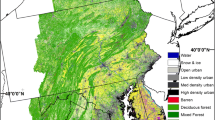Abstract
Ecological mapping attempts to objectively and spatially delimit and represent the natural organization and structure of the landscape. It offers nested levels of resolution, based upon a regionalization process, and provides an ecological basis for planning activities that may impact upon the environment.
The essential principles of ecological mapping, as applied by the Quebec Ministry of Environment and Wildlife, are summarized. A methodological mapping approach is proposed for the determination of significant land portions for forest management using an ecological map at a scale of 1:50 000. At this scale, two nested levels of perception are expressed: 1) the topographic complex, and 2) the topographic entity. The topographic entity can be further subdivided into working units based upon operational criteria oriented to forest management. Within each nested level from topographic complex to working unit, there is a corresponding increase in the amount of detailed information available. Ecological mapping undertaken at 1:50 000 scale can provide a reliable and robust tool for planning forest management activities. In most cases, major ecological variations can be expressed and mapped at this scale; however, a greater degree of generalization must be accepted in the planning process when working at this scale rather than at larger scales.
Similar content being viewed by others
References
BaileyR.G., PfisterR.D. and HendersonJ.A.: 1978, ‘Nature of land and resource classification — a review’, J. For. 76, 650–655.
Barnes, B.V.: 1986, VlsVarieties of experience in classifying and mapping forestland ecosystem’, In: Site Classification in Relation to Forest Management, COJFRC Symposium Proceedings O-P-14, Ont. Min. Nat. Res. and Can. for. Serv., Sault Ste. Marie, Ontario, pp. 5–23.
BélangerL., GagnéR. and PineauM.: 1990, ‘L'utilisation des données écologiques dans la pratique forestière au Québec’, Forestry Chronicle 66, 372–376.
BélangerL., BergeronY. and CamiréC.: 1992, ‘Ecological land survey in Quebec’, Forestry Chronicle 68, 42–52.
Ducruc, J.P., Parent, G. and Chabot, G.: 1993, ‘Cartographie écologique et unité de paysage: application au milieu boréal québécois, partie 1: L'unité de paysage, unité naturelle fonctionnelle’, IUFRO S1.02.06, Réunion technique sur la classification et l'évaluation des stations, Clermont-Ferrand, France.
GerardinV. and DucrucJ.P.: 1979, ‘L'inventaire du Capital-Nature: Un outil québécois d'aménagement intégré du territoire et de gestion des ressources’, Revue forestière française, Numéro spécial XXXI, 224–233.
GerardinV. and DucrucJ.P.: 1990, ‘The ecological reference framework for Québec: a useful tool for forest site evaluation’, Vegetatio 87, 19–27.
Gerardin, V. and Parent, G.: 1993, ‘Cartographie écologique et unité de paysage: application au milieu boréal québécois, partie 2: L'unité de paysage, structure portante de la typologie des milieux’, IUFRO S1.02.06, Réunion technique sur la classification et l'évaluation des stations, Clermont-Ferrand, France.
JurdantM., BeaubienJ.L., BélairL., DionneJ.C. and GerardinV.: 1972, ‘Carte écologique de la écologique de la région du Saguenay/Lac St-Jean, Notice explicative, vol. 1: l'environnement et ses ressources: identification, analyse et évaluation’, Rapport d'information Q-F-X-31, Centre de Recherches Forestières des Laurentides, Environnement Canada, Québec, 93 pp.
Jurdant, M., Bélair, J., Gerardin, V. and Ducruc, J.P.: 1977, ‘L'inventaire du Capital-Nature, méthode de classification et de cartographie écologique du territoire’, Série de la classification écologique, No. 2, Gouv. du Canada, Min. de l'Env., Direction générale des terres, 202 pp.
RoweJ.S.: 1961, ‘The level of integration concept and ecology’, Ecology 42, 420–427.
RoweJ.S.: 1991, ‘Forests as landscape ecosystems: implications for their regionalization and classification’, In: D.L.Mengel and D.T.Tew (eds.), Ecological Land Classification: Applications to Identify the Productive Potential of Southern Forests, Proceedings of Symposium, Jan. 7–9, 1991, Gen. Tech. Rep. No. SE-68, US Dep. Agric., For. Serv., Southeastern For. Exp. Station, Charlotte, North Carolina, pp. 3–9.
RoweJ.S.: 1992, ‘Forest site classification in Canada: a current perspective’, Forestry Chronicle 68, 22–24.
SwiftJ.: 1983, Cut and Run, the Assault on Canada's Forests, Between the Lines Publishing, Toronto, Ontario, 285 pp.
Author information
Authors and Affiliations
Rights and permissions
About this article
Cite this article
Beauchesne, P., Ducruc, JP. & Gerardin, V. Ecological mapping: A framework for delimiting forest management units. Environ Monit Assess 39, 173–186 (1996). https://doi.org/10.1007/BF00396143
Issue Date:
DOI: https://doi.org/10.1007/BF00396143



